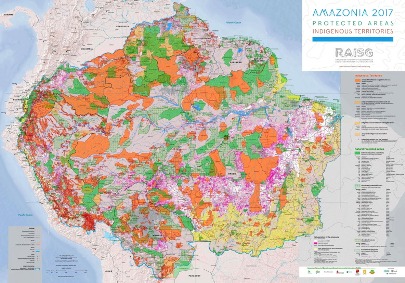Factors of success in community forest conservation.

This article explores how relevant predictions from two theories (Olson, 1965; Ostrom, 1990) that underpin, either implicitly or explicitly, the design and implementation of Community Based Conservation (CBC) efforts were, in practice.
Themes: Conservation, FPIC, Human rights, Indigenous people, Livlihoods, NGOs, Parks
Abstract: Drawing on structured interviews of 29 conservation practitioners with first‐hand experience working with successful community forest conservation projects in eight countries around the world, this article explores how context influences the importance of Mancur Olson's five requisites for collective action, and Elinor Ostrom's eight design principles for effective common‐pool resource management. Results suggest that Olson was correct that social cohesion is a common attribute of successful community forest management efforts. But the survey also suggests that it is shared identity that is most the important contributor to cohesion and that this can occur largely absent of regular, positive face‐to‐face interactions as Olson suggests. Interviews also show that all eight of Ostrom's design principles are manifest by successful community forest conservation efforts. Although recognition of a community rights to self‐determination was reported to be essential, it was also considered insufficient without the timely and competent support of national authorities to help communities effectively exercise their rights when faced with threats from more economically and politically powerful external actors.
More…
Mar 28, 2021

COMACO, from snares to plowshares:

A conservation and human wellbeing success story.
Themes: Conservation, NGOs, Livlihoods, Poverty, REDD
Community Markets for Conservation is a private sector, not-for-profit social
enterprise in Zambia. It was established in 2003 to halt wildlife poaching and
illegal tree cutting for charcoal by helping poor rural families to increase their
food and income security through improved farming practices and marketing
of value-added agricultural commodities. COMACO supports 178,891 farmers
in the Luangwa Valley, providing them with improved farming skills, seed
loans, a premium price for their crop surplus, and a dividend if they comply
with sustainable farming and wildlife, and forest conservation best practices.
Maize yields using COMACO methods increased by 63% and net income was
37% higher than for farmers who purchased inorganic fertilizers. Between
2012 and 2018 the number of food secure families increased from 67–84%. Elephant poaching has declined in all but one COMACO district, poaching is now
primarily conducted by nonlocal hunters, and leg-hold snare detections by
community game scouts have decreased significantly in COMACO areas.
Increasing food and income security while reducing deforestation and
unsustainable hunting for ~$US10 per farmer per year is cheap and can be replicated in Zambia and other nations in Africa.
More…
Sep 29, 2020

Cornered by PAs:

Adopting rights-based approaches to enable cost-effective conservation and climate action
Themes: CBD, Conservation, Indigenous people, Parks, Poverty
Progress on many commitments made in past decades to respect the rights of Indigenous Peoples in conservation is too limited.
Rights violations affect IPs culture, well-being, livelihoods, and security without evidence of resulting conservation outcomes. Protected Areas Financing is limited and heavily public spending, not support of Indigenous and community conservation. Regular global monitoring of progress and access to grievance are key to accelerate progress or secure conservation outcomes.
More…
Mar 10, 2020
The fatal flaws of compassionate conservation.

A short discussion of the ethical boundaries of our varied interpretations of what constitutes a compassionate view of conservation.
Themes: Animal rights, Conservation, Human rights
More…
Jun 09, 2019
The Serengeti-Mara squeeze.

one of the world’s most iconic ecosystems under pressure.
Themes: Agriculture, Conservation, Policy, Parks, Pastoralists
New finding alters our view on what is needed to protect biodiversity.
More…
Apr 01, 2019

Did indigenous conservation ethics exist?
Themes: Conservation, Indigenous people
Abstract - Despite the common assertion that some indigenous peoples were conservationists, a number of authors have claimed that persuasive evidence for this is lacking. They have, apparently, overlooked such evidence. It is well documented, for example, that centuries ago Pacific Islanders invented and employed all the basic marine conservation measures that Europeans began to use only in the early 1900s. For islanders to have devised and employed deliberate conservation measures, they first had to learn that their natural resources were limited. They could only have done so by depleting them. Evidence that a culture overharvested or otherwise damaged its natural resources at some period in its history is no proof that it was, for all times, non-conservationist. Some Pacific Island cultures learned that their marine resources were limited and introduced marine conservation measures accordingly. Others never learned this lesson because their marine resources always exceeded harvesting pressure. I suggest that a worldwide survey of relevant literature would show that societies that developed con-scious conservation practices were usually small and relied on natural resources that were circum-scribed and thus easily depleted. Today, in an era of shrinking natural resource frontiers, establishing whether a conservation ethic exists in an indigenous culture is a vital first step in determining how to help its people live within their natural resource limits.
More…
Mar 16, 2019

Just Conservation - What is it and how should we pursue it?
Frameworks for resolving conflict sometimes neglect basic principles of conservation; and frameworks for resolving conflict sometimes neglect basic principles of social justice.
Efforts to realize conservation are often met with stakeholders contending that particular conservation actions are unfair for conflicting with their basic interests. A useful lens through which to view such conflict is social justice, which may be considered the fair treatment of others judged according three principles: equality, need, and desert (noun form of deserve). We formally demonstrate that (i) the subject of social justice (others) includes many non-human elements of nature and (ii) realizing conservation that is also socially just requires being guided by a non-anthropocentrism principle, whereby no human should infringe on the well-being of others any more than is necessary for a healthy, meaningful life. The concept, “healthy, meaningful life” is less vague and subjective than might be presupposed. That concept is for example subject to considerable objective reasoning through social and behavioral sciences. We indicate how realizing socially-just conservation requires another guiding, safeguard principle: If a significant and genuine conservation interest calls for restricting a human interest, that restriction should occur except when doing so would result in injustice. When the restriction would be unjust every effort should be made by all involved parties to mitigate the restriction to the point of no longer being unjust. This principle covers concerns often raised when conservation is opposed – e.g., financial costs, loss of cultural tradition. We explain how these two principles are neglected or excluded by many methods for resolving conservation conflicts and collaborative governance of natural resources.
More…
Jan 29, 2019

Transborder Protected Areas, Green Infrastructure, and Local Communities:

Perspectives on the Kavango-Zambezi Transfrontier Conservation Area.
Themes: Conservation, Parks, Tourism, Indigenous people, Fisheries
An overview of the issues, opportunities constraints and problems affecting the world's largest multi-country park.
More…
Jun 19, 2018








